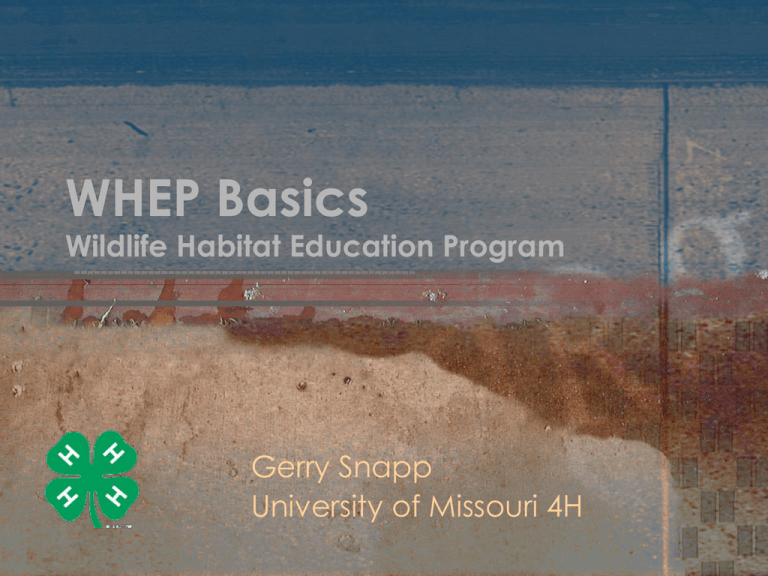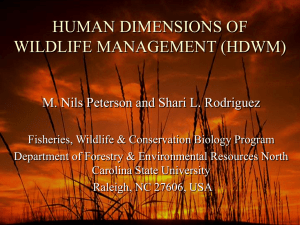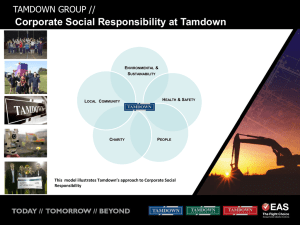WHEP…the Basics - Missouri 4-H
advertisement

WHEP Basics Wildlife Habitat Education Program Gerry Snapp University of Missouri 4H Regions • Ecological regions: Areas of the country that have similar climate, vegetation and wildlife. • WHEP has identified 14 different regions within the continental United States…plus 2 special microenvironments that can be found within any region -Urban and Wetlands. Missouri Regions • Look at the US map in the manual. • How many regions does it show for Missouri? • Look at how Missouri experts divide the state into regions. Glaciated Prairie Tallgrass/Mixed Prairie Un-glaciated Prairie Tallgrass/Mixed Prairie Ozark Eastern Deciduous Forest Southeastern Lowland Southeast Mixed Forest Eastern Deciduous Forest Eastern Deciduous Forest • Most of the terrain is rolling except for the Appalachian Mountains (& Ozarks) which are steep. • Average annual precipitation 35-90 inches • Summers - hot and dry; Winters –cold • Final stage of succession is tall broadleaf trees • Prior to fire-suppression, oak savannahs & woodlands. • Large areas of the region have been cleared of native vegetation for the production of crops and livestock. Species – Eastern Deciduous Forest • • • • • • • • • • American woodcock brown thrasher eastern meadowlark golden-winged warbler great horned owl mourning dove northern bobwhite ovenbird wild turkey wood duck • • • • • • bobcat eastern cottontail eastern gray squirrel gray fox Indiana bat white-tailed deer • eastern box turtle • timber rattlesnake • largemouth bass/ bluegill Tallgrass/Mixed Prairie Great Plains Grassland Tallgrass/Mixed Prairie • • • • Terrain is flat to rolling plains Average annual precipitation: 20-40 inches Winters cold – summers hot Climax vegetation typically tall grasses, i.e. bluestems, Indian grass, switchgrass • Variety of forbs – sunflowers, broomweed, ragweed • Shrubs and trees in drainages and other moist areas. • Potholes (wetlands) caused by glaciation Species – Tallgrass/mixed prairie • blue-winged teal • dickcissel • grasshopper sparrow • greater prairie chicken • mourning dove • northern bobwhite • northern harrier • ring-necked pheasant • wild turkey • • • • coyote eastern cottontail red fox White-tailed deer • plains hog-nosed snake • bluegill/largemouth bass Southeast Mixed Forest • Nothing yet URBAN Urban – • Dense human population, with residential and/or commercial development, connected and cris-crossed infrastructure (roads, train tracks, utilities). • Great variety of vegetation; annual plantings, (garden & flowers) perennial grasses & forbs, shrubs, young and mature trees. • Landscapes typically manipulated vs. “natural” • Relatively small and fragmented • Often dominated by non-native, invasive vegetation • Wildlife areas include parks, trails, backyards. Species - Urban • • • • • • • • • American robin common nighthawk bluebird* European starling house finch house sparrow house wren northern flicker peregrine falcon • rock pigeon • ruby-throated hummingbird • song sparrow • • • • • • big brown bat cottontail* coyote eastern gray squirrel raccoon white-tailed deer Wetlands • Next on the to-do list What you need to know to compete General – not region specific • Wildlife management concepts • Wildlife management terms What you need to know to compete Region Specific • Species & applicable Wildlife Management Practices (WMPs) for the specific region – see Regions section (pgs. 27-85) • Wildlife species & habitat requirements – – foods, preferred successional stage, use of space/edge, etc. (pgs. 86-253) • Identify the species -hides, tracks, feathers, photos, eggs, scat, etc. • Understand the WMPs (pgs. 254-304) Wildlife Management Practices • Practices vary from region to region • Practices that work for a species in one region may not be practical for same species in another region Species & WMPs (chart) How to use the manual • Determine which ecoregion • Determine the featured species • Locate and mark the selected species in the Wildlife Species section. • Locate and mark the appropriate WMPs for the region/species • Study! Tip: No need to duplicate every page of manual for students – just the featured species Points to remember • Wildlife ID – may be male/female; adult/juvenile • Full credit – complete common name; spelled correctly, including correct use of capitalization. National Contest events I. Wildlife Management Practices – checklist/chart II. Wildlife management plan – Written plan (team) – Oral defense of written plan (individual) III. Wildlife Challenge Demonstrate skill at wildlife identification and general wildlife knowledge including ecoregions, wildlife management concepts & terms, biology and ecology of the species, identification of common wildlife foods and which species utilize those foods. Missouri State Contest 2014 I. II. III. IV. Wildlife Mgt. Practices General Wildlife Knowledge Wildlife ID Written Management Plan (simplified for JR) 35 pts. 30 pts. 20 pts. 15 pts. Written Management Plan (pages 307 – 312) • Three pieces of paper provided • Use one side only of each • 2 pages for narrative – paragraph form • 1 page for sketch – Map of property showing where practices should be implemented. • This is a team event Senior score sheet Junior Score Sheet (M0)








